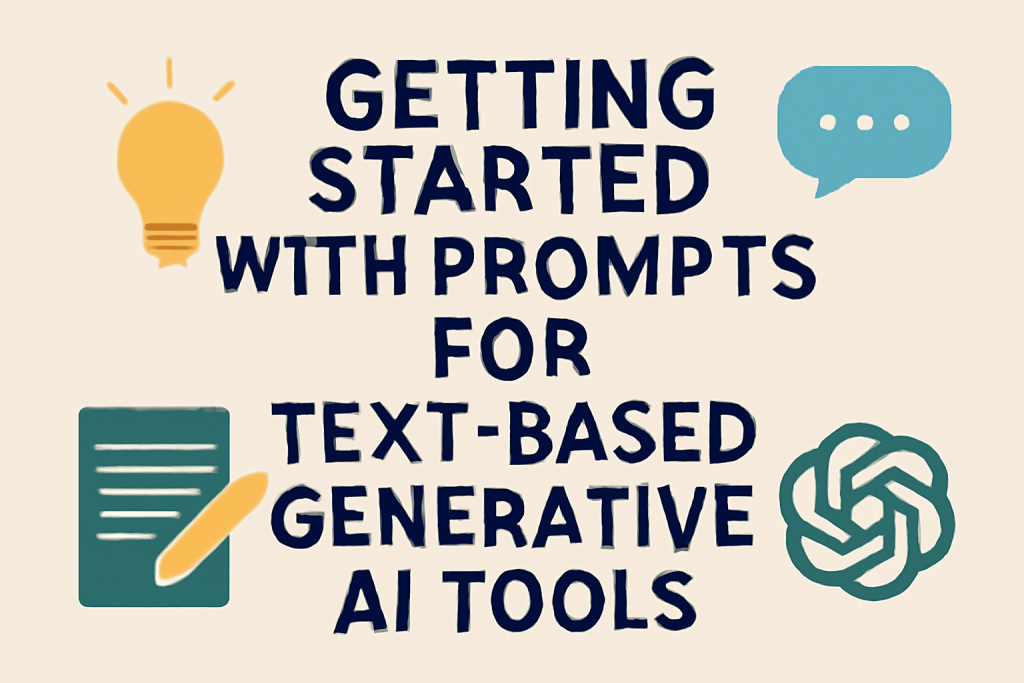In recent years, generative AI tools have become increasingly popular for various applications, ranging from creative writing to business content generation. One of the most exciting aspects of these tools is their ability to generate text based on user inputs, or prompts. However, using text-based generative AI tools effectively requires a solid understanding of how to craft well-structured prompts. This article will guide you through the basics of getting started with prompts for text-based generative AI tools.
What Are Prompts?
A prompt is simply the input or instruction that you provide to a text-based generative AI system. Prompts can range from a single sentence to complex, multi-part questions or instructions. The way you phrase your prompt has a significant impact on the quality and relevance of the generated output.
Generative AI models like GPT (Generative Pre-trained Transformer) are trained on vast amounts of text data and use that training to predict and generate coherent responses based on the prompts they are given. Essentially, a prompt is the starting point for the AI to generate content, and it serves as the bridge between your idea and the AI’s output.
Why Prompts Matter
The effectiveness of generative AI depends heavily on how well you phrase your prompts. Inaccurately or vaguely phrased prompts may lead to poor, irrelevant, or confusing responses. Conversely, well-structured prompts enable the AI to generate more accurate, relevant, and useful content.
Key Factors to Consider When Crafting Prompts
- Clarity: Be clear about what you want. Ambiguity can lead to unintended results.
- Detail: The more specific your prompt, the more tailored the AI’s response will be.
- Tone: Adjust the tone of your prompt based on the kind of response you’re looking for—whether it’s formal, casual, technical, or creative.
- Context: Providing context can help the AI understand the background and nuances of the task at hand, leading to more meaningful responses.
Types of Prompts
Here are several types of prompts you can use with text-based generative AI tools:
1. Basic Information Requests
This is one of the simplest and most common types of prompts. You provide a question, and the AI responds with relevant information.
Example Prompt:
What is quantum computing?
Output:
Quantum computing is a type of computation that takes advantage of quantum mechanics, a branch of physics that deals with the behavior of matter and energy on the smallest scales. It differs from classical computing by using quantum bits or qubits, which can exist in multiple states simultaneously, allowing for exponentially faster computation for certain types of problems.
2. Creative Writing Prompts
Generative AI tools are often used for creative writing, including generating stories, poems, and other literary forms. The more detailed your prompt, the more engaging and unique the generated content will be.
Example Prompt:
Write a short story about a young woman who discovers a hidden magical world under her city.
Output:
(A short story unfolds, introducing the main character, her discovery of the magical world, and the challenges she faces as she navigates this hidden realm.)
3. Content Generation Prompts
AI tools can help generate business-related content, such as blog posts, social media updates, and marketing materials. When crafting prompts for these purposes, make sure to specify the audience, tone, and content goal.
Example Prompt:
Write a 500-word blog post about the importance of mental health in the workplace, targeted at HR professionals. Make sure to include statistics and actionable tips.
Output:
(The AI would produce a detailed, well-researched post that includes insights into mental health in the workplace, backed by statistics and offering tips for HR professionals.)
4. Rewriting and Paraphrasing Prompts
Generative AI tools can also be used to rewrite or paraphrase existing content. This can be particularly useful for generating fresh versions of articles, emails, or social media posts.
Example Prompt:
Rewrite the following sentence to make it sound more formal: “We need to get this done ASAP.”
Output:
“It is essential that we complete this task as soon as possible.”
5. Exploratory Prompts
These prompts are designed to get the AI to think creatively or generate multiple perspectives on a topic. They can be used for brainstorming ideas or exploring different angles of an issue.
Example Prompt:
What are five innovative ways businesses can reduce their carbon footprint?
Output:
(The AI generates a list of creative, sustainable strategies businesses could adopt to lower their environmental impact, such as transitioning to renewable energy, adopting circular economy principles, etc.)
6. Analysis and Insight Prompts
Generative AI can also analyze text and provide summaries or insights. These prompts are typically used when you want the AI to evaluate existing content and offer a breakdown of key points.
Example Prompt:
Summarize the main points of the following article about AI ethics in healthcare.
Output:
(The AI would extract and condense the most critical points of the article, potentially offering insights about the ethical dilemmas involved in AI use within the healthcare industry.)
Best Practices for Writing Effective Prompts
To make the most of generative AI tools, follow these best practices when crafting your prompts:
- Be Specific: The more specific you are, the better the AI’s response will be. For example, instead of asking for “a story,” specify “a mystery story set in a small town in the 1980s.”
- Use Context: If you’re working on a longer project or need multiple steps, provide context or break your prompt into smaller parts. For example, when generating a novel, provide the first chapter and then prompt the AI for the next one.
- Experiment with Variations: Don’t be afraid to tweak and experiment with your prompts. You may find that slight changes can dramatically improve the quality of the output.
- Iterate: Sometimes, it may take a few tries to get the result you’re looking for. Don’t hesitate to adjust your prompt if the initial output isn’t perfect.
- Provide Examples: When appropriate, provide examples of what you’re looking for, especially if you want the AI to replicate a certain style, tone, or format.
Conclusion
Getting started with text-based generative AI tools is as much about experimenting and refining your prompts as it is about using the technology itself. By understanding the importance of clarity, specificity, and context, you can create prompts that lead to high-quality, relevant outputs. Whether you’re using AI for writing, content creation, brainstorming, or analysis, mastering prompt crafting will help you unlock the full potential of these powerful tools. As you gain more experience, you’ll develop an intuitive sense of how to get the best results from your prompts, turning generative AI into a valuable resource for a wide range of applications.



